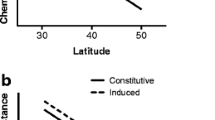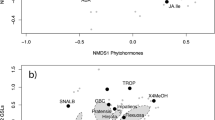Abstract
Spatial variation in chemical defense of plants can be caused by genetic, biotic, and abiotic factors. For example, many plants exhibit a latitudinal cline in chemical defense, potentially due to latitudinal variation in abiotic environmental factors such as the light regime during the growing season. In the worldwide distributed Plantago lanceolata, the levels of deterrent iridoid glycosides (IGs), aucubin and catalpol, vary geographically, including latitudinally. To examine whether latitudinal variation in photoperiod can explain part of this geographic variation, plants from the Netherlands and Finland were exposed to two different photoperiods, simulating the Dutch (middle European) and Finnish (northern European) light period during the growing season. The experiment showed that although most variation in IG content was genetic, plants from both Dutch and Finnish origin produce relatively more catalpol under a northern European than under a middle European photoperiod. Our results confirm that latitudinal effects on photoperiod can contribute to geographic variation in plant defense chemistry, which should be considered when studying latitudinal clines in plant-enemy interactions.


Similar content being viewed by others
References
Adler LS, Schmitt J, Bowers MD (1995) Genetic-variation in defensive chemistry in Plantago lanceolata (Plantaginaceae) and its effect on the specialist herbivore Junonia coenia (Nymphalidae). Oecologia 101:75–85
Alexander JM, van Kleunen M, Ghezzi R, Edwards PJ (2012) Different genetic clines in response to temperature across the native and introduced ranges of a global plant invader. J Ecol 100:771–781
Anderberg A, Anderberg A-L (2009) Svärtkampar, Plantago lanceolata L. http://linnaeus.nrm.se/flora/di/plantagina/plant/planlan.html. Accessed 21-5-2014
Barton KE (2008) Phenotypic plasticity in seedling defense strategies: compensatory growth and chemical induction. Oikos 117:917–925
Benjamini Y, Krieger A, Yekutieli D (2006) Adaptive linear step-up procedures that control the false discovery rate. Biometrika 93:491–507
Biere A, Marak HB, van Damme JMM (2004) Plant chemical defense against herbivores and pathogens: generalized defense or trade-offs? Oecologia 140:430–441
Bowers MD (1983) The role of iridoid glycosides in host-plant specificity of checkerspot butterflies. J Chem Ecol 9:475–793
Bowers MD (1991) Iridoid glycosides. In: Rosenthal GA, Berenbaum MR (eds) Herbivores: their interactions with secondary plant metabolites. Academic, San Diego, pp 297–325
Bowers MD, Puttick GM (1988) Response of generalist and specialist insects to qualitative allelochemical variation. J Chem Ecol 14:319–334
Bowers MD, Stamp NE (1992) Chemical variation within and between individuals of Plantago lanceolata (Plantaginaceae). J Chem Ecol 18:985–995
Bowers MD, Stamp NE (1993) Effects of plant-age, genotype, and herbivory on Plantago performance and chemistry. Ecology 74:1778–1791
Cavers PB, Bassett IJ, Crompton CW (1980) The biology of Canadian weeds. 47, Plantago lanceolata L. Can J Plant Sci 60:1269–1282
Coley PD, Aide TM (1991) Comparison of herbivory and plant defenses in temperate an tropical broad-leaved forest. In: Price PW, Lewinsohn TM, Fernandes GW, Benson WW (eds) Plant-animal interactions: evolutionary and ecology in tropical and temperate regions. Wiley, New York, pp 25–49
Damtoft S, Jensen SR, Nielsen BJ (1983) The biosynthesis of iridoid glucosides from 8-epi-deoxyloganic acid. Biochem Soc T 11:593–594
Darrow K, Bowers MD (1997) Phenological and population variation in iridoid glycosides of Plantago lanceolata (Plantaginaceae). Biochem Syst Ecol 25:1–11
de Deyn GB, Biere A, van der Putten WH, Wagenaar R, Klironomos JN (2009) Chemical defense, mycorrhizal colonization and growth responses in Plantago lanceolata L. Oecologia 160:433–442
Dobzhansky T (1950) Evolution in the tropics. Am Sci 38:209–221
Duff RB, Bacon JSD, Mundie CM, Farmer VC, Russell JD, Forrester AR (1965) Catalpol and methylcatalpol: naturally ocurring glycosides in Plantago and Buddleia species. Biochem J 96:1–5
Fajer ED, Bowers MD, Bazzaz FA (1992) The effect of nutrients and enriched CO2 environments on production of carbon-based allelochemicals in Plantago: a test of the carbon/nutrient balance hypothesis. Am Nat 140:707–723
Foggo A, HIggins S, Wargent JJ, Coleman RA (2007) Tri-trophic consequences of UV-B exposure: plants, herbivores and parasitoids. Oecologia 154:505–512
Haeggström C-A, Haeggström E (2008) Ålands flora. Marienhamn, Finland
Hårdh JE, Persson AR, Lottosson L (1977) Quality of vegetables cultivated at different latitudes in Scandinavia. Acta Agric Scand 27:81–96
Harvey JA, Gols R, Wagenaar R, Bezemer TM (2007) Development of an insect herbivore and its pupal parasitoid reflect differences in direct plant defense. J Chem Ecol 33:1556–1569
Herms DA, Mattson WJ (1992) The dilemma of plants: to grow or defend. Q Rev Biol 67:283–335
Ho C-K, Penning SC (2013) Preference and performance in plant-herbivore interactions across latitude—a study in U.S. Atlantic salt marshes. PLoS One 8:e59829
Jaakola L, Hohtola A (2010) Effect of latitude on flavonoid biosynthesis in plants. Plant Cell Environ 33:1239–1247
Jarzomski CM, Stamp NE, Bowers MD (2000) Effects of plant phenology, nutrients and herbivory on growth and defensive chemistry of plantain, Plantago lanceolata. Oikos 88:371–379
Jones CG, Firn RD (1991) On the evolution of plant secondary chemical diversity. Phil T Roy Soc B 333:273–280
Karban R, Baldwin IT (1997) Induced responses to herbivory. Chicago University Press, Chicago
Kennedy GG, Yamamoto RT, Dimock MB, William WG, Bordner J (1981) Effect of day length and light intensity on 2-tridecanone levels and resistance in Lycopersicon hirsuta to Manduca sexta. J Chem Ecol 7:707–716
Kessler A, Baldwin IT (2002) Plant responses to insect herbivory: the emerging molecular analysis. Annu Rev Plant Biol 53:299–328
Kim TN (2014) Plant damage and herbivore performance change with latitude for two old-field plant species, but rarely as predicted. Oikos 123: 886–896
Klockars GK, Bowers MD, Cooney B (1993) Leaf variation in iridoid glycoside content of Plantago lanceolata (Plantaginaceae) and oviposition of the buckeye, Junonia coenia (Nymphalidae). Chemoecology 4:72–78
Lampinen R, Lahti T (2013) Kasviatlas 2012. Helsingin Yliopisto, Helsinki
Li Y, Yu D, Xu X, Xie Y (2005) Light intensity increases the suceptibility of Vallisneria natans to snail herbivory. Aquat Bot 81:265–275
MacArthur RH (1972) Geographical ecology: patterns in the distribution of species. Princeton University Press, Princeton
Marak HB, Biere A, van Damme JMM (2000) Direct and correlated responses to selection on iridoid glycosides in Plantago lanceolata L. J Evol Biol 13:985–996
Marak HB, Biere A, van Damme JMM (2002a) Systemic, genotype-specific induction of two herbivore-deterrent iridoid glycosides in Plantago lanceolata L. in response to fungal infection by Diaporthe adunca (Rob.) Niessel. J Chem Ecol 28:2429–2448
Marak HB, Biere A, van Damme JMM (2002b) Two herbivore-deterrent iridoid glycosides reduce the in-vitro growth of a specialist but not of a generalist pathogenic fungus of Plantago lanceolata L. Chemoecology 12:185–192
Moles AT (2013) Dogmatic is problematic: interpreting evidence of latitudinal gradients in herbivory and defense. Ideas Ecol Evol 6:1–4
Moles AT, Bonser SP, Poore AGB, Wallis IR, Foley WJ (2011a) Assesing the evidence for latitudinal gradients in plant defence and herbivory. Funct Ecol 25:380–388. doi:10.1111/j.1365-2435.2010.01814.x
Moles AT et al (2011b) Putting plant resistance traits on the map: a test of the idea that plants are better defended at lower latitudes. New Phytol 191:777–788
Nieminen M, Suomi J, van Nouhuys S, Sauri P, Riekkola ML (2003) Effect of iridoid glycoside content on oviposition host plant choice and parasitism in a specialist herbivore. J Chem Ecol 29:823–844
Pankoke H, Müller C (2013) Impact of defoliation on the regrowth capacity and the shoot metabolite profile of Plantago lanceolata L. Plant Physiol Biochem 71:325–333
Pereyra PC, Bowers MD (1988) Iridoid glycosides as oviposition stimulants for the buckeye butterfly, Junonia coenia (Nymphalidae). J Chem Ecol 14:917–928
Pike N (2011) Using false discovery rates for multiple comparisons in ecology and evolution. Methods Ecol Evol 2:278–288
Primack RB, Antonovics J (1982) Experimental ecological genetics in Plantago. VII Reproductive effort in populations of P. lanceolata L. Evolution 36:742–752
Quintero C, Bowers MD (2012) Changes in chemical defenses and nutritional quality as a function of ontogeny in Plantago lanceolata (Plantaginaceae). Oecologia 168:471–481
Reudler JH, Biere A, Harvey JA, Van Nouhuys S (2011) Differential performance of a specialist and two generalist herbivores and their parasitoids on Plantago lanceolata. J Chem Ecol 37:765–778
Reudler Talsma JH, Biere A, Harvey JA, van Nouhuys S (2008) Oviposition cues for a specialist butterfly: plant chemistry and size. J Chem Ecol 34:1202–1212
Richards LA, Dyer LA, Smilanich AM, Dodson CD (2010) Synergistic effects of amides from two piper species on generalist and specilaist herbivores. J Chem Ecol 36:1105–1113
Richards LA, Lampert EC, Bowers MD, Dodson CD, Smilanich AM, Dyer LA (2012) Synergistic effects of iridoid glycosides on the survival, development and immune repsonse of a specilaist caterpillar, Junonia coenia (Nymphalidae). J Chem Ecol 38:1276–1284
Roberts MR, Paul ND (2006) Seduced by the dark side: integrating molecular and ecological perspectives on the influence of light on plant defence against pests and pathogens. New Phytol 170:677–699
Schemske DW, Mittelbach GG, Cornell HV, Sobel JM, Roy K (2009) Is there a latitudinal gradient in the importance of biotic interactions. Annu Rev Ecol Evol Syst 40:245–269
Schmelzer GH, Gurib-Fakim A, Arroo RRJ, Bosch CH, de Ruyter A, Simmonds MSJ (2008) Medicinal plants 1 vol 11. Plant resources of tropical Africa. Backhuys Publishers, Wageningen
Simms EL (1992) Costs of plant resistance to herbivory. In: Fritz RS, Simms EL (eds) Plant resistance to herbivores and pathogens: ecology, evolution, and genetics. University of Chicago Press, Chicago, pp 392–425
Stamp NE, Bowers MD (1994) Effects of cages, plant age and mechanical clipping on plantain chemistry. Oecologia 99:66–71
Van Alstyne KL, Dethier MN, Duggins DO (2001) Spatial patterns in macroalgal chemical defenses. In: Mcclintock JB, Baker BJ (eds) Marine chemical ecology. CRC Press, New York, pp 301–324
van der Meijden R (1996) Heukels’ flora van Nederland, 22nd edn. Wolters-Noordhoff, Groningen
WallisDeVries MF (2001) Habitat quality assessment and its role in the conservation of the butterfly Melitaea cinxia. Proc Exp Apll Ent 12:141–146
Wilkens RT, Spoerke JM, Stamp NE (1996) Differential responses of growth and two soluble phenolics of tomato to resource availability. Ecology 77:247–258
Woods EC, Hastings AP, Turley NE, Heard SB, Agrawal AA (2012) Adaptive geographical clines in the growth and defence of a native plant. Ecol Monogr 82:149–198
Zangerl AR, Berenbaum MR (1993) Plant chemistry, insect adaptations to plant chemistry, and host plant utilization patterns. Ecology 74:47–54
Acknowledgments
We thank Jimi Kirvesoja for help with the chemical analyses, Remieke Niermeyer and Annamien Koomen for collecting seeds in Ede, the Netherlands. We thank Sandra Varga, two anonymous reviewers and an editor for helpful comments on previous versions of this manuscript. This research was funded by the Academy of Finland grant 128508 to JHR. JAE acknowledges funding from the Finnish Cultural Foundation.
Author information
Authors and Affiliations
Corresponding author
Rights and permissions
About this article
Cite this article
Reudler, J.H., Elzinga, J.A. Photoperiod-Induced Geographic Variation in Plant Defense Chemistry. J Chem Ecol 41, 139–148 (2015). https://doi.org/10.1007/s10886-015-0550-5
Received:
Revised:
Accepted:
Published:
Issue Date:
DOI: https://doi.org/10.1007/s10886-015-0550-5




